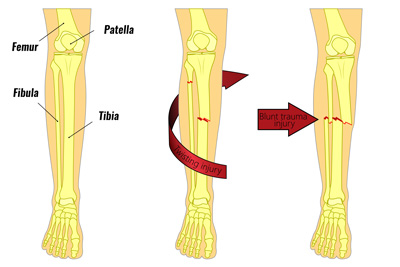
how health care professionals diagnose these fractures.what parts of the lower leg are involved.It is sometimes surprising to patients that the doctors pay so much attention to the tibia and so little to the fibula. As a result it does not need to be perfectly straight when it heals. This bone serves mainly as an anchor point for muscle and hardly bears any weight. Usually, when the shaft of the tibia is broken the fibula, the smaller bone of the lower leg, is broken as well. Fracture of the tibia has a reputation for complications including failure to heal, or nonunion, so the management of this injury needs a careful approach from orthopaedic surgeons. As a result, fracture of the tibia is one of the most common major long bone fractures encountered in adults. The tibia is relatively easy to fracture with twisting or bending forces.

There is no overlying muscle to cushion impact on the front and inner side of the bone. Fractures of the upper end of the tibia are covered in knee fractures.The tibia bone is the largest and most important bone of the lower leg. Fractures of the lower end of the tibia and fibula are covered in ankle fractures. We will limit this discussion to fractures of the shaft, or mid section of these two bones. The two bones in the lower leg are the tibia and fibula. In this guide we are concerned with fractures of the lower leg between the knee and ankle. Welcome to Therapy Specialists Inc’s guide to lower leg fractures. Published by Elsevier Ltd.Physical or Occupational Therapy in Cleveland for Lower Leg Fractures Future studies should aim to establish patient specific risks models for complications and re-operations, such that clinicians can anticipate them and adjust and individualize treatment strategies.Ĭomplications Fractures Intramedullary nailing Subsequent surgery Tibia.Ĭopyright © 2020. However, based on current data it remains difficult to identify specifiers and determinants of an individual patient with specific fracture characteristics at risk for complications. Patients treated with intramedullary nailing for tibial fractures need to be consented for high probability of adverse events as anterior knee pain, subsequent surgical procedures and bone healing problems are relatively common. Nail revision and bone-grafting to promote union were applied in 4% and 2% respectively. Dynamization of the nail to promote union was reported in 8% of the cases. The most frequent indication of subsequent surgery was screw removal due to pain or discomfort (9%). Eighteen percent of patients required at least one subsequent surgery. The most frequent complication was anterior knee pain (23%), followed by non-union (11%).


Incidence of complications and rate of re-operations were reported with descriptive statistics.įifty-one studies involving 8110 patients treated with intramedullary nailing for traumatic tibial fractures were included. Inclusion of studies and critical appraisal of the evidence was performed by two independent authors. Studies were included if authors included more than 50 patients treated with intramedullary nailing for traumatic tibial fractures. Searches were limited to English studies published after January 1st, 1998. Trip Database, Medline, Scopus and Cochrane Library were searched on September 7th, 2018. To improve our understanding on how we may improve trauma care for patients with tibial shaft fractures, this study systematically reviewed all currently available evidence to assess the incidence of complications and rate of re-operations following intramedullary nailing of traumatic tibial fractures. Nevertheless, complications occur frequently, and subsequent surgery is often required. Intramedullary nailing of tibial shaft fractures has been common practice for decades.


 0 kommentar(er)
0 kommentar(er)
